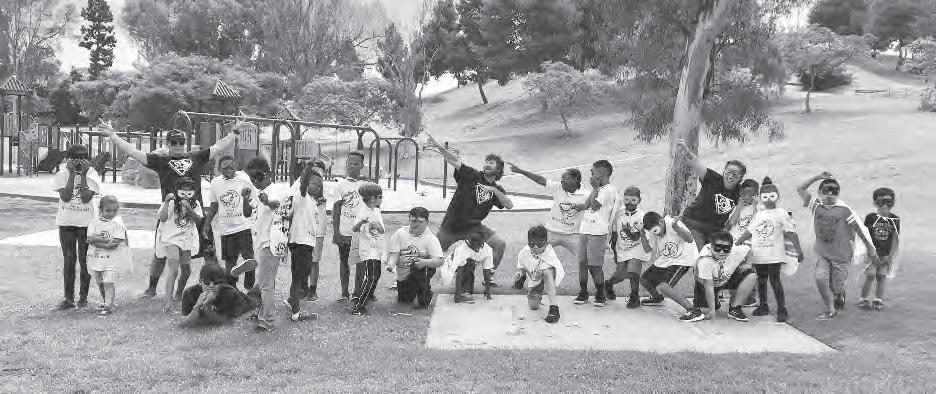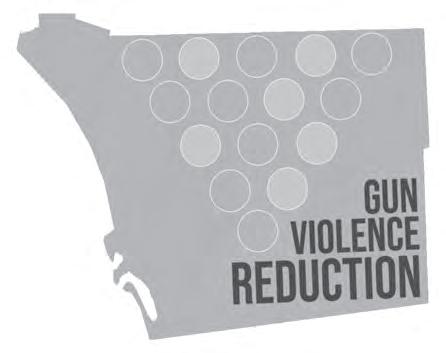
10 minute read
ARTICLE CONTINUATION
permeated our criminal justice system, as documented by the California Task Force to Study and Develop Reparation Proposals for African Americans.” The bill further emphasizes that courts must consider the disparate impact on historically disenfranchised and system-impacted populations when exercising their discretion in determining appropriate sentences.
The California task force, which Governor Gavin Newsom established in 2020 to investigate the possibility of implementing statewide reparations to address the legacy of slavery and racism, inspires the legislation. The task force recently released its final recommendations, which the state legislature is reviewing. These recommendations would be sent to the
“I argued against ending affirmative action in California before the (University of California) UC Board of Regents over 20 years ago,” Lee posted on Twitter on July 2. “I knew then what I know now: ignoring race doesn’t make racism go away. It makes it worse.”
On the same day as the SCOTUS’ decision, the California Task Force to Study and Develop Reparations Proposals for African Americans submitted its 1,075-page final report to the California legislature.
The report includes 115 recommendations and a request for a formal apology from the state for state laws, policies and practices that disproportionately and negatively affected Black Californians.
Ethnic Media Service and California Black Media invited litigators who defended Affirmative Action before the U.S. Supreme Court to reflect on the court’s ruling and its broader impact two days after 11 members of CLBC convened at the State Capitol to express their opinions on the ruling.
A discussion about next steps for racial equity, including a lawsuit against “legacy admissions” at Harvard, was also addressed. Legacy admissions give special consideration to children of alumni during enrollment decisions.
Part of the litigation team, Jin Hee Lee, Director governor’s desk for approval if implemented.
The task force’s comprehensive 1,000-page report proposes various statewide policies and outlines methodologies to calculate monetary reparations for historical injustices against Black Americans. The report highlights the lasting consequences of slavery and systemic racism today.
Notably, the task force estimates that each eligible Black Californian has incurred a minimum of $1 million in harm caused or preventable by the state.
Regarding criminal justice, the task force found that qualifying Black residents may be entitled to compensation of over $115,000—roughly of Strategic Initiatives at the Legal Defense Fund (LDF), was one of the participants on the panel. LDF represented clients of color and alumni organizations at Harvard who opposed the dismantling of Affirmative Action, from the trial level to the Court of Appeals, to SCOTUS.
“It will make it extremely difficult for universities to be able to consider race as part of the admission process,” Lee said. “(The decision) is a blow to efforts to advance equal opportunities and racial equality in our educational system which suffers from tremendous dysfunction and inequality.”
Three days after SCOTUS’s ruling, the Lawyers for Civil Rights (LCR), a legal nonprofit in Boston, filed a civil rights complaint against Harvard with the Education Department. LCR is arguing Harvard’s legacy admissions process unfairly benefits White family members, many who donate money to the school. According to College Transitions, approximately 75% of the top 100 colleges in the U.S., including all Ivy League schools and most elite private universities, favor legacy status.
Sen. Steven Bradford (D-Gardena), vice chair of the CLBC, expressed his views on legacy admissions.
“This begs the question: is this court committed to putting everyone on an equal footing? Well, then legacy admissions should be addressed as well if that’s the case,” Bradford said. “A recent study found that 43% of White students admitted to Harvard were admitted based on legacy, based on family members, based on donors, based on athletes, or again, based on faculty or staff. Why should children of alumni and wealthy donors get special treatment? This is wrong.”

$2,352 per year of residency in California from 1971 to 2020. This compensation would address issues such as over-policing in Black communities, excessive felony drug arrests, and disproportionate prison sentences during the so-called war on drugs.
Additionally, the final report proposed measures to abolish cash bail and end the prosecution of low-level offenses. Bill 852 seeks to build upon the task force’s findings and recommendations by requiring California courts to actively combat racial bias in sentencing. The legislation aims to ensure fairer outcomes for Black individuals and other marginalized communities by considering race as a factor.
Justice Clarence Thomas, the second Black man appointed to the high court, wrote that the decision exposes universities’ admissions policies as “rudderless, race-based preferences” to ensure a specific racial mix in their classes.
Those who disagree with the court’s ruling believe the fight for racial justice in higher education, particularly for African Americans, is not over.
A coalition of California business groups and corporation owners said in a statement that the “statewide business community remains steadfast” in its “commitment to creating job opportunities and improving the diversity of our businesses across all sectors.”
“As part of our ongoing commitment, we will work to educate employers about the Supreme Court’s decision and how we can ensure that our employees and their families continue to know they are an integral part of our businesses and our communities.”
California Education Chief Thurmond Considers Run for Governor
California’s chief elected education officer, State Superintendent of Public Instruction Tony Thurmond, is considering a run for governor in 2026.
On July 5, Thurmond announced that he has formed a campaign committee.
“Working families across California are facing so many challenges that require our entire state government working together to solve,” Thurmond said in the statement. “Growing up as a Black and Latino kid without my parents, I lived the struggles that so many Californians face every day — that’s why I dedicated my career to fighting for a brighter future for California’s children.”
Gov. Newsom Updates State’s Opioid Plan to Include New Deadly Drug “Tranq”
Gov. Gavin Newsom has updated his strategy to combat opioid abuse in California by introducing measures to address a new deadly drug xylazine, also known as ‘tranq’ on the streets.
This animal sedative is increasingly being mixed with fentanyl, making it even more deadly. According to data from the Centers for Disease Control and Prevention (CDC), the percentage of fatal opioid overdoses involving ‘tranq’ increased by 276%, from 2.9% to 10.9% between January 2019 through June 2022.
Newsom’s ‘Master Plan for Tackling the Fentanyl and Opioid Crisis’ focuses on holding the opioid pharmaceutical industry accountable, cracking down on drug trafficking and raising awareness about the dangers of opioids. The plan includes addressing emerging threats like ‘tranq.’
“California has an all-hands-on-deck strategy for tackling the fentanyl and opioid crisis impacting every community across our state,” said Newsom in a statement. “Education and outreach are critical tools in our arsenal to prevent tragedy, to connect people with treatment, and to fight the life-threatening stigma that stops too many people from getting help.”
California has allocated $30 million to fund the production of naloxone, the anti-overdose drug. Newsom has also increased anti-drug-trafficking operations, especially at the San Ysidro border crossing in San Diego, where a significant amount of fentanyl enters into the state.
A G Bonta Releases Reports on Crime, Juvenile Justice, Guns, Homicides and Use of Force
Continued from cover THE JACKSONS AND VILLAGE PEOPLE


California Attorney General Rob Bonta announced the release of the annual Homicide in California, Crime in California, Use of Force Incident Reporting, Juvenile Justice in California, and Crime Guns in California statistical reports (found at data-openjustice.doj. ca.gov)
The reports contain statistics for 2022 as submitted by California law enforcement agencies and other criminal justice organizations.
Findings indicated 612 civilians were involved in incidents that involved the discharge of a firearm or use of force resulting in serious bodily injury or death. Of those civilians: 48.4% were Hispanic. 25.3% were White, and a disproportionate 19.3% were Black. Black Californians account for about 5.72% of the state’s population.
In 2022, there were 2206 homicides reported in the state, a decrease of 6.6% from 2361 reported in 2021. The rate of violent crime per 100,000 people increased by 6.1% from 466.2 in 2021 to 494.6 in 2022. The homicide arrest rate decreased by 5.9% in 2022 compared to 2021 and the violent offense arrest rate increased by 3.4% compared to 2021.
“Having access to good data is a cornerstone of responsible public policy. The data released today is essential for understanding, preventing, and combating crime,” said Bonta. “In 2022, California made significant progress towards reducing its homicide rates, but more remains to be done. While crime rates remain significantly below their historical highs, property and violent crimes continue to have devastating consequences for communities across the state.”
SUNDAY, JULY 16

As part of an effort to bring communities together and create safer neighborhoods, San Diego Mayor Todd Gloria, San Diego City Council President Sean Elo-Rivera, San Diego County Health and Human Services Director Nick Machionne, and the San Diego Parks Foundation today announced the launch of “Parks After Dark,” a new “Come Play Outside” program that will transform three San Diego neighborhood parks into community festivals every weekend this summer.
San Diego's “Parks After Dark” will be held on Thursday, Friday and Saturday nights at the City Heights, Linda Vista, and Skyline Hills Recreation Centers from 69 p.m. from July 14 through Aug. 27. The events will feature live entertainment, activities for all ages, games and free meals for kids.
“We’re so grateful to our partners at the County, Parks Foundation and Price Philanthropies for making three of our popular neighborhood parks centers of fun and community for families on summer nights,” San Diego Mayor Todd Gloria said. “These hosted nighttime activities will create lasting summer memories in a safe, healthy and fun environment.”
The City of San Diego received a $500,000 grant from the County of San Diego to launch the program.
“Parks After Dark” is based on a popular County of Los Angeles program and is designed to reduce crime and bring communities together by creating safe places to enjoy and play on summer nights.
“This program builds on the success of last year's 'Come Play Outside' programs and will give folks of all ages something to celebrate in their community this summer,” said Michel Anderson, San Diego Parks Foundation Board Chair.

The program is made possible by the City of San Diego, the County of San Diego, and Price Philanthropies Foundation. Free activities include City Heights con - certs, free Teen Nites, movies, Outdoor adventures nature camps, Learn To Swim Aquatics programs, and more. The 2022 "Parks After Dark" and the City’s new “Come Play Outside” schedule and activities can be found online at comeplaysd. com.
Here’s a few programming locations for easy reference:
Park After Dark Locations
City Heights Recreation Center 4380 Landis Street San Diego, CA 92105 (619) 641-6125
Linda Vista Recreation Center 7064 Levant Street San Diego, CA 92111 (858) 573-1392
Skyline Hills Recreation Center 8285 Skyline Drive
San Diego, CA 92114 (619) 527-3486
FREE TEEN NITE
PROGRAM LOCATIONS

Linda Vista Recreation Center 7064 Levant Street San Diego, CA 92111 (858) 573-1392
Golden Hill Recreation Center 2600 Golf Course Dr San Diego, CA 92102 (619) 235-1138
Paradise Hills Recreation Center 6610 Potomac St. San Diego, CA 92139
(619) 527-3419
Col. Irving Salomon San Ysidro Community Activity Center 179 Diza Road San Diego 92173
(619) 424-0472
City Heights Recreation Center 4380 Landis Street San Diego, CA 92105 (619) 641-6125
Southcrest Recreation Center 4149 Newton St. San Diego, CA 92113 (619) 527-3413
Encanto Recreation Center 6508 Wunderlin Ave. San Diego, CA 92114 (619) 527-3411
Dolores Magdaleno Memorial Recreation Center 2902 Marcy Ave. San Diego, CA 92113 (619) 235-1125
Martin Luther King Jr. Recreation Center 6401 Skyline Drive San Diego, CA 92114 (619) 527-3415
Cesar Chavez Recreation Center 455 Sycamore Road San Ysidro, CA 92173
Colina del Sol Recreation Center 5319 Orange Ave. San Diego, CA 92115 (619) 235-1144
Skyline Hills Recreation Center 8285 Skyline Drive San Diego, CA 92114 (619) 527-3486
Montgomery-Waller Community Park 3020 Coronado Ave San Diego,
Monday, San Diego Hunger Coalition held a press conference at Northgate Gonzalez Market store located in Barrio Logan with an urgent announcement to inform households in California that they can request a reissuance of the P-EBT (Pandemic Electronic Benefits Transfer) 2.0 card. Households who think they qualified but did not receive a P-EBT 2.0 card in 2021 should call the helpline number 1.800.887.8230.
Families only have one month to claim these benefits through August 1, 2023.
Anahid Brakke, CEO of San Diego Hunger Coalition stated that “at $1,192 per student, helping families recoup missed PEBT 2.0 benefits is, by far, the single biggest and most important opportunity our community has to reduce summer hunger in 2023. This is an allhands-on deck situation to get the word out.”
P-EBT is a federal program that was set up to provide money for groceries while schools and childcare were closed during the Public Health Emergency. Benefits are issued on an EBT card to the families of children who were eligible to replace the free or reduced-price meals served at childcare or schools that children may have missed because of the pandemic.
P-EBT 2.0 benefits were issued to children who were eligible for free or reducedpriced meals and/or in the CalFresh program from October 2020 - August 2021. All P-EBT 2.0 cards should have been received by December 2021, however, data uncovered by San Diego Hunger Coalition revealed that an estimated 32,500 students in San Diego County who were eligible did not receive their cards. The average P-EBT 2.0 benefit amount for each student is $1,200 which is approximately $38.7 million available to families if they call California Department of Social Services in the month of July to reclaim their lost benefits. While hunger affects children of all ages, races and ethnicities, nutrition insecurity affects children of color at much higher rates than their white counterparts.

The County of San Diego recently released a report that highlights data related to gun violence in San Diego County and outlines recommendations to reduce this violence. The Gun Violence Community Needs Assessment Final Report, authored by Health Assessment and Research for Communities (HARC), includes findings from more than 18 months of work with community and government leaders.
As stated in the report, be tween 2017-21, over 70% of firearm-related deaths in San Diego County were suicide and over 28% were homicide. The report details populations most impacted by firearm-related deaths, injuries, and crimes, including age, race, and geographic location.
Recommendations in the report include prevention and intervention strategies tailored to specific populations at highest risk for vio lence, such as developing and sharing suicide prevention materials, domestic and intimate partner violence, and working to change norms about gun violence through outreach programs. It also highlights the need to partner with agencies that offer free gun locks.

Enhancing community prevention services is also mentioned in the report, includ ing expanding youth-focused pro grams, like mentor ship and after school programs. Partnership building between trauma hospitals and community-based organi zations that connect gun violence patients and their families to recovery services is also highlighted as a recommendation.
Community engagement and collaboration is central to many of the recommenda tions. The County is devel oping a work plan, using HARC’s recommendations, to advance gun violence reduction activities in the county. The report and work plan will be presented to the County Board of Supervisors on July 18.
A link to the report can be found at sandiegocoun ty. gov.










